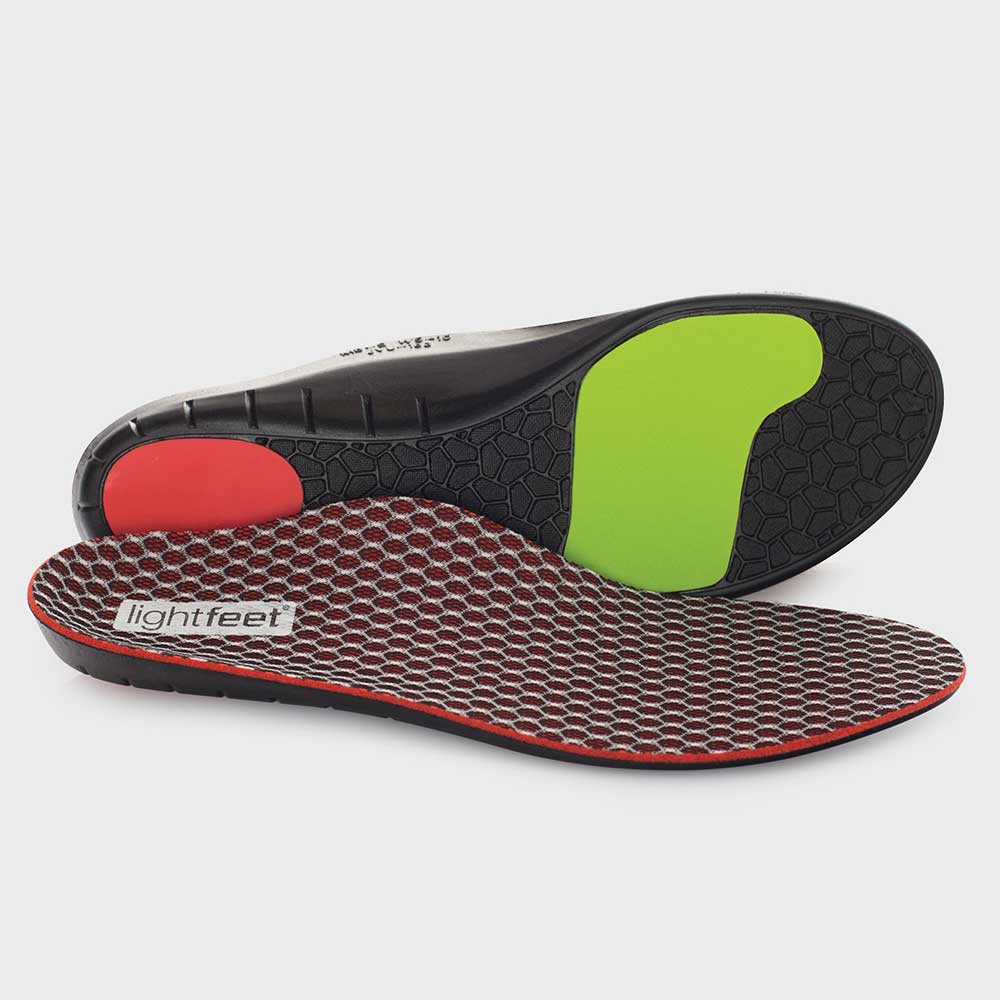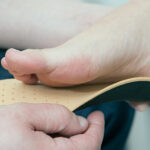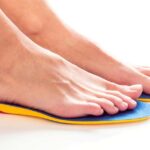The Best Insoles for High Arches: Addressing the Challenges of High Arches with Support and Comfort”
High arches, while less common than flat feet, present unique challenges. This article explores the world of insoles tailored specifically for high arches, providing both support and comfort. To make an informed choice, it’s essential to grasp the intricacies of high arches.
Understanding High Arches
Understanding high arches, also known as pes cavus, is crucial for finding the right footwear and support to ensure comfort and prevent potential foot problems. A high arch is a condition where the arch of the foot is raised more than the typical arch shape. This condition can vary in severity and impact each person differently.
People with high arches often experience a number of challenges, including:
- Increased Pressure on Ball and Heel: Due to the arch’s elevated shape, the ball and heel of the foot bear more weight, which can lead to pain and discomfort.
- Stability Issues: High arches can affect the stability of the foot, making it more prone to ankle sprains or balance difficulties.
- Limited Shock Absorption: The arch of the foot helps in absorbing the shock during walking or running. A higher arch may not compress as easily, reducing the foot’s natural shock-absorbing capability.
- Foot Pain and Discomfort: People with high arches may experience foot pain, particularly in the arch area, due to the increased tension on the arch ligaments and muscles.
- Risk of Other Foot Conditions: High arches are often associated with conditions like plantar fasciitis, metatarsalgia (pain in the ball of the foot), and claw toes or hammertoes due to the altered shape and mechanics of the foot.
- Difficulty in Finding Proper Footwear: Standard shoes may not provide adequate support for high arches, leading to discomfort and exacerbating existing problems.
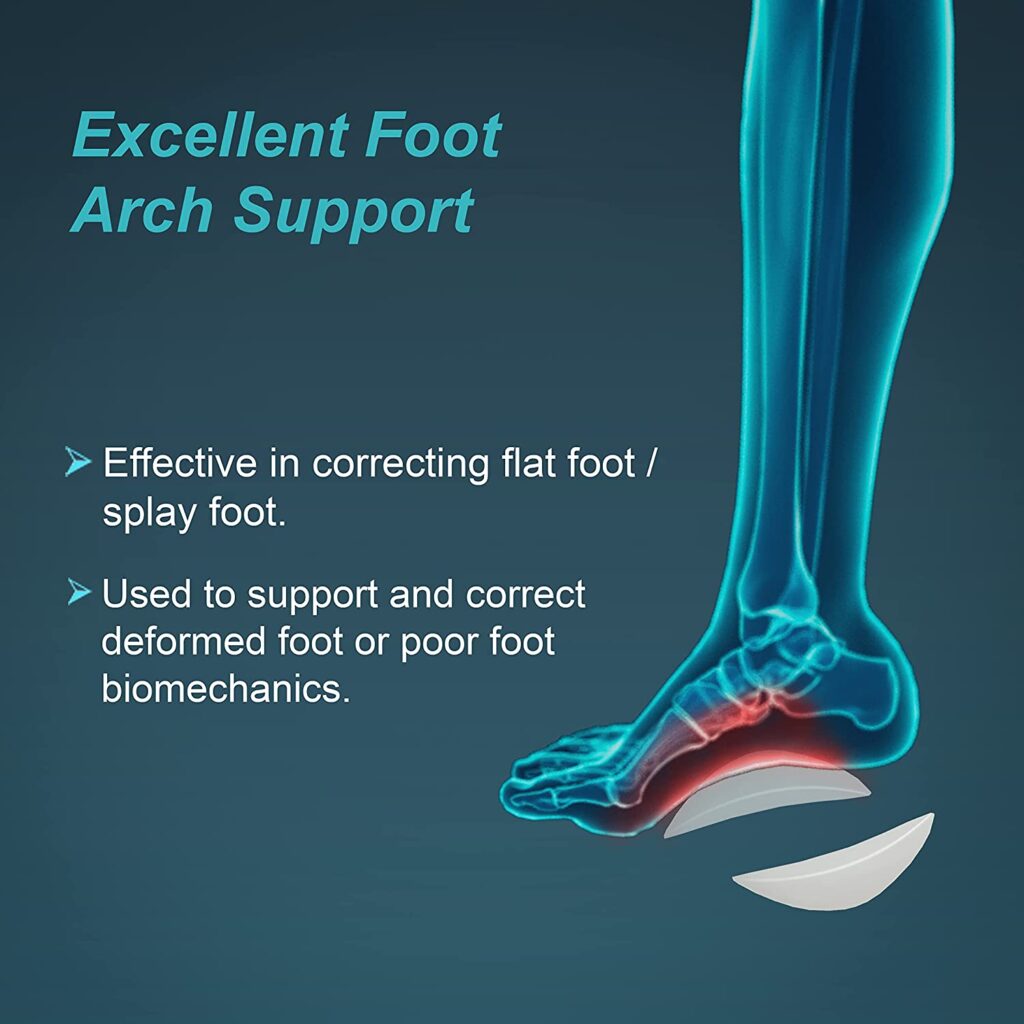
Why Insoles Matter for High Arches
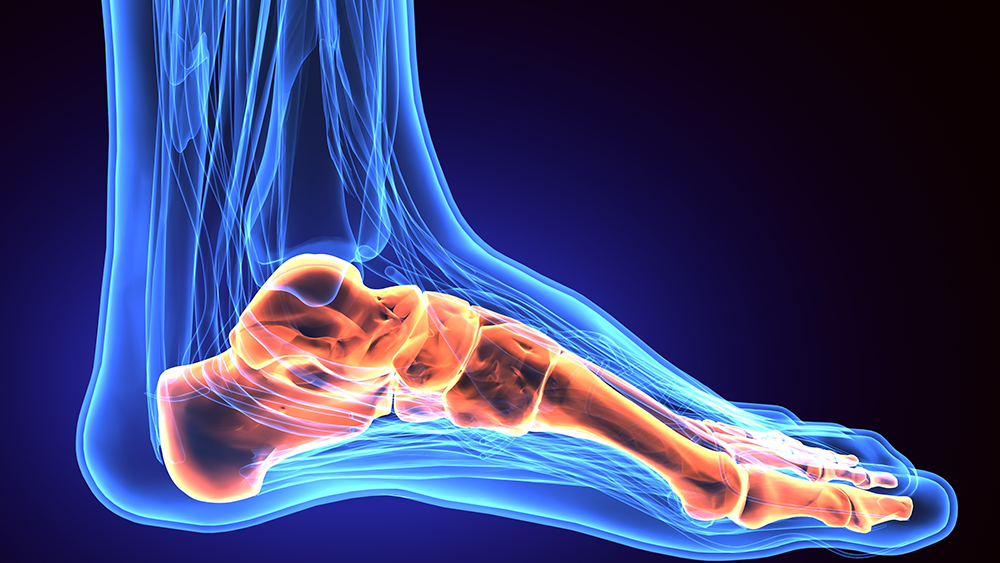
Insoles are particularly important for individuals with high arches due to several reasons:
- Enhanced Arch Support: High arches require additional support to maintain proper foot alignment. Insoles designed for high arches are structured to provide the necessary support, preventing the arch from collapsing under body weight.
- Improved Weight Distribution: People with high arches often experience uneven weight distribution across their feet, leading to increased pressure on the forefoot and heel. Quality insoles help distribute this pressure more evenly, reducing the risk of pain and discomfort.
- Increased Comfort: Insoles can add cushioning to areas of the foot that bear more weight, particularly the ball and heel, enhancing overall comfort during activities like walking, running, or standing for extended periods.
4. Reduced Foot Pain: By supporting and cushioning the arch, insoles can alleviate pain caused by conditions commonly associated with high arches, such as plantar fasciitis, metatarsalgia, and heel pain.
5. Prevention of Further Foot Problems: Regular use of appropriate insoles can help prevent the development of additional foot issues and complications that can arise from having high arches, such as ankle instability or toe deformities.
6. Improved Footwear Fit: Insoles can make standard footwear more suitable for high-arched feet, providing a better, more comfortable fit and reducing the likelihood of blisters and other irritations caused by ill-fitting shoes.
7. Enhanced Athletic Performance: For athletes, insoles designed for high arches can improve foot mechanics, which may enhance athletic performance and reduce the risk of injuries related to poor foot alignment.
Criteria for Choosing the Best Insoles
Selecting the best insoles for your feet, especially if you have high arches, involves considering several key criteria to ensure optimal comfort and support:
- Arch Support: The insole should provide adequate support for your arch type. For high arches, the insole needs to have a pronounced arch to effectively support the foot’s natural structure.
- Material: Insoles are made from various materials like foam, gel, leather, or a combination. Foam offers good cushioning and support, gel provides excellent shock absorption, and leather is durable and molds well to the foot.
- Cushioning: Look for insoles with good cushioning, particularly in the heel and forefoot areas, to alleviate pressure points and provide comfort during prolonged periods of standing or walking.
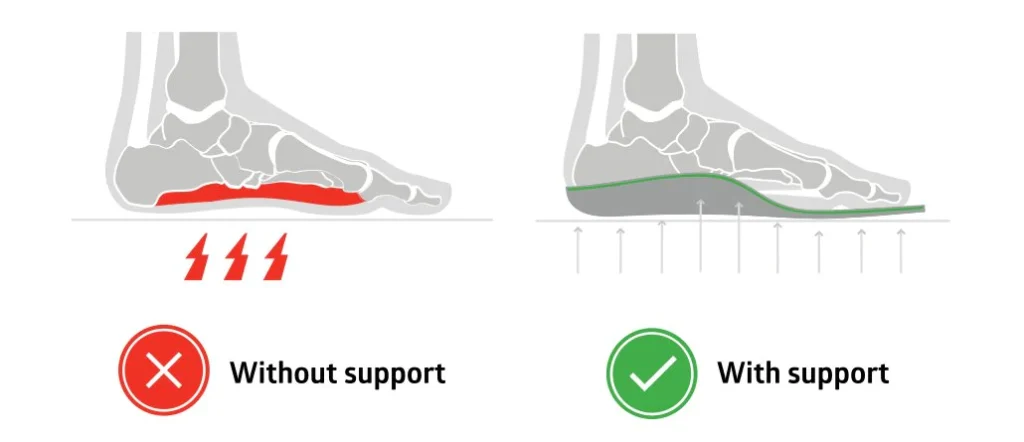
4. Fit and Size: Ensure the insole fits your shoe properly. Some insoles are full-length, while others are ¾ length or designed for specific shoe types like dress shoes or athletic footwear.
5. Footbed Type: Consider whether you need a rigid, semi-rigid, or soft footbed. Rigid footbeds offer the most support and are ideal for structural abnormalities. Semi-rigid provides balance between support and cushioning, while soft footbeds are more about cushioning and less about support.
6. Activity Level: Your activity level and the types of activities you engage in should influence your choice. Athletes might need more supportive and durable insoles compared to those needed for everyday wear.
7. Durability: Higher quality insoles may cost more, but they often last longer and provide better support and comfort over time.
8. Heat Moldability: Some insoles can be heat-molded for a custom fit to your foot’s shape, providing enhanced comfort and support.
9. Moisture-Wicking and Breathability: Insoles with moisture-wicking properties help keep feet dry and comfortable, reducing the risk of blisters and fungal infections.
10. Orthopedic Needs: If you have specific foot conditions or orthopedic requirements, look for insoles that address these needs.
11. Expert Recommendations: Consult with a podiatrist or foot care specialist for recommendations, especially if you have ongoing foot issues or pain.
12. Brand Reputation and Reviews: Research different brands and read user reviews to gauge the effectiveness and satisfaction level of different insole types.
Top Picks: Expert Reviews on Insoles for High Arches
Atlas Arch Support
Key Features of Atlas Arch Support:
- Innovative Design: The Atlas Arch Support is known for its innovative design, providing robust arch support without being bulky, making it suitable for various shoe types.
- Customizable Fit: These supports offer a personalized fit, adapting to the wearer’s unique foot shape, ensuring maximum comfort and effectiveness.
- Durable Materials: Crafted from high-quality, durable materials, Atlas Arch Support maintains its shape and support even with prolonged use.
- Balanced Support and Flexibility: They strike a perfect balance between firm support and flexibility, offering comfort while effectively supporting the arch and evenly distributing foot pressure.
- Deep Heel Cup: The deep heel cup enhances stability and helps with shock absorption, reducing the risk of strain and discomfort.
User Testimonials:
- Sarah K.: “I’ve struggled with arch pain for years, but Atlas Arch Support has been a game-changer for me. The custom fit is fantastic, and I can wear them with all my shoes.”
- Mike J.: “I’m an athlete, and these supports have significantly improved my performance and reduced foot fatigue. Highly recommended!”
- Emily S.: “I love the deep heel cup; it makes such a difference in how my feet feel at the end of the day. Worth every penny.”
Recommendation:
Atlas Arch Support is highly recommended for individuals seeking effective arch support, comfort, and versatility in their footwear. Whether you have arch-related issues, are an athlete, or simply want to enhance the comfort of your shoes, these supports offer a well-balanced solution. The customizable fit and innovative design make them a top choice for those looking to improve foot health and comfort.
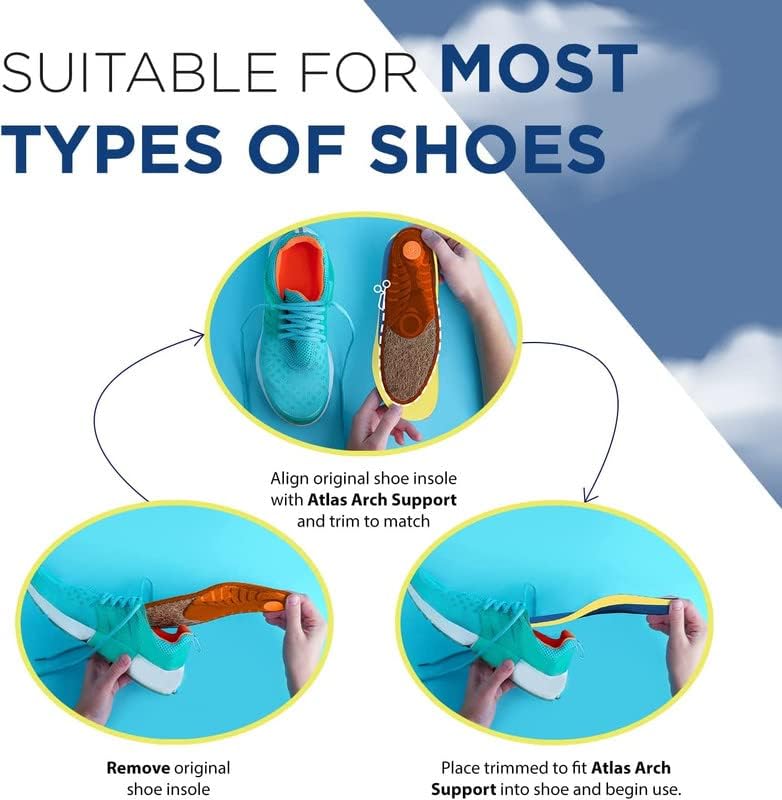
Pros & Cons:
| Pros | Cons |
| Effective Arch Support: Atlas Arch Support provides excellent arch support, making it suitable for individuals with arch-related issues. | Price: Some users may find them slightly more expensive compared to standard arch supports. |
| Versatile: These supports can be used in a wide range of shoes, from athletic to casual, without compromising comfort. | May Not Fit All Shoes: While versatile, they may not fit well in extremely narrow or tight-fitting shoes. |
| Long-lasting: Made from durable materials, they are designed to withstand daily wear and maintain their support over time | Initial Discomfort: Some users may experience initial discomfort when transitioning to Atlas Arch Support, especially if they have never used arch supports before. It may take a brief adjustment period for the feet to adapt to the new support |
| Customizable: The supports conform to the wearer’s foot shape, offering a tailored fit and personalized comfort | Limited Color and Style Options: Atlas Arch Support primarily focuses on functionality, and as a result, there may be limited color and style options available. Users looking for specific aesthetic preferences in their arch supports may find the choices somewhat limited. |
| Innovative Design: Their unique design sets them apart from traditional arch supports | May Not Address Severe Foot Conditions: While Atlas Arch Support is effective for general arch support and comfort, it may not provide sufficient relief for individuals with severe foot conditions that require specialized orthotics or medical attention. In such cases, consulting a healthcare professional may be necessary. |
Powerstep Pinnacle Orthotic Insoles
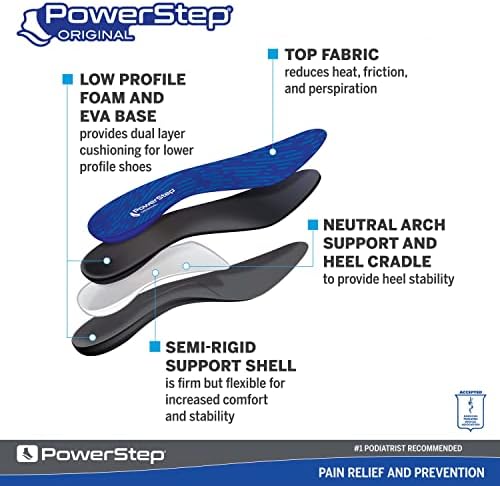
Key Features of Powerstep Pinnacle Orthotic Insoles:
- Advanced Arch Support: The Powerstep Pinnacle Orthotic Insoles are renowned for their advanced arch support, providing relief for various arch-related issues.
- Dual-Layer Cushioning: They feature a dual-layer cushioning system, combining comfort and support for all-day wear.
- Deep Heel Cradle: The deep heel cradle enhances stability and aids in shock absorption, reducing strain on the feet and joints.
- Anti-Microbial Top Fabric: The top fabric is treated with an anti-microbial agent, preventing the growth of odor-causing bacteria.
- Flexible Arch Shell: These insoles incorporate a flexible arch shell that adapts to the contours of the foot while providing support.
- Versatile Fit: They are designed to fit in various shoe types, from athletic to casual, making them versatile for everyday use
User Testimonials:
- John R.: “I’ve been dealing with plantar fasciitis for years, and Powerstep Pinnacle Insoles have been a lifesaver. My feet have never felt better.”
- Lisa M.: “The cushioning is fantastic, and they fit perfectly in my running shoes. I can now run without any discomfort.”
- David H.: “I was skeptical at first due to the price, but these insoles are worth every penny. My foot pain has significantly reduced since I started using them.
Recommendation:
Powerstep Pinnacle Orthotic Insoles are highly recommended for individuals seeking superior arch support, comfort, and versatility in their footwear. Whether you have specific foot conditions or simply want to enhance the comfort of your shoes for everyday wear, these insoles offer an excellent balance of support and cushioning. The deep heel cradle and anti-microbial top fabric make them a top choice for those looking to alleviate foot discomfort and maintain foot hygiene.
Pros & Cons:
| Pros | Cons |
| Exceptional Arch Support: These insoles are highly effective in providing arch support, relieving discomfort associated with conditions like plantar fasciitis and flat feet. | Initial Adjustment Period: Some users may experience an initial adjustment period as their feet adapt to the added support and cushioning |
| Superior Cushioning: The dual-layer cushioning system ensures comfort without sacrificing support, ideal for those who spend long hours on their feet. | May Not Fit All Shoes: While versatile, these insoles may not fit well in shoes with very limited space inside, such as tight-fitting dress shoes. |
| Deep Heel Cradle: The deep heel cradle enhances stability and minimizes the risk of overpronation, reducing the likelihood of injuries | Price: They are priced slightly higher than basic insoles, which may not be budget-friendly for everyone |
| Anti-Microbial Top Fabric: The anti-microbial treatment keeps the insoles fresh and odor-free. | May Take Up Shoe Space: Due to their dual-layer cushioning and arch support, these insoles can take up some space inside the shoe. In certain cases, this may make the shoes feel slightly tighter, which could be uncomfortable for individuals with very snug-fitting footwear. |
| Customizable Fit: Powerstep Pinnacle Insoles can be trimmed for a customized fit in a variety of shoe sizes. | Not Suitable for Very High Arches: While these insoles offer excellent arch support, they may not provide sufficient support for individuals with extremely high arches who require specialized orthotics designed specifically for their arch profile |
Sole Active Thick Insoles
Key Features of Sole Active Thick Insoles:
- Enhanced Arch Support: The Sole Active Thick Insoles are designed with enhanced arch support, catering to individuals with various arch types and foot conditions.
- Deep Heel Cup: They feature a deep heel cup that stabilizes the heel and helps absorb shock, reducing strain on the feet and lower limbs.
- High-Quality Cushioning: These insoles are equipped with high-quality cushioning materials that provide exceptional comfort during extended wear.
- Sustainable and Eco-Friendly: Sole is committed to sustainability, and their insoles are made from recycled materials, making them an eco-friendly choice.
- Odor-Resistant Top Layer: The top layer of these insoles is treated to be odor-resistant, ensuring a fresh and hygienic in-shoe environment.
- Custom Moldable: Sole Active Thick Insoles are heat-moldable, allowing users to customize the fit to their unique foot shape for maximum comfort.
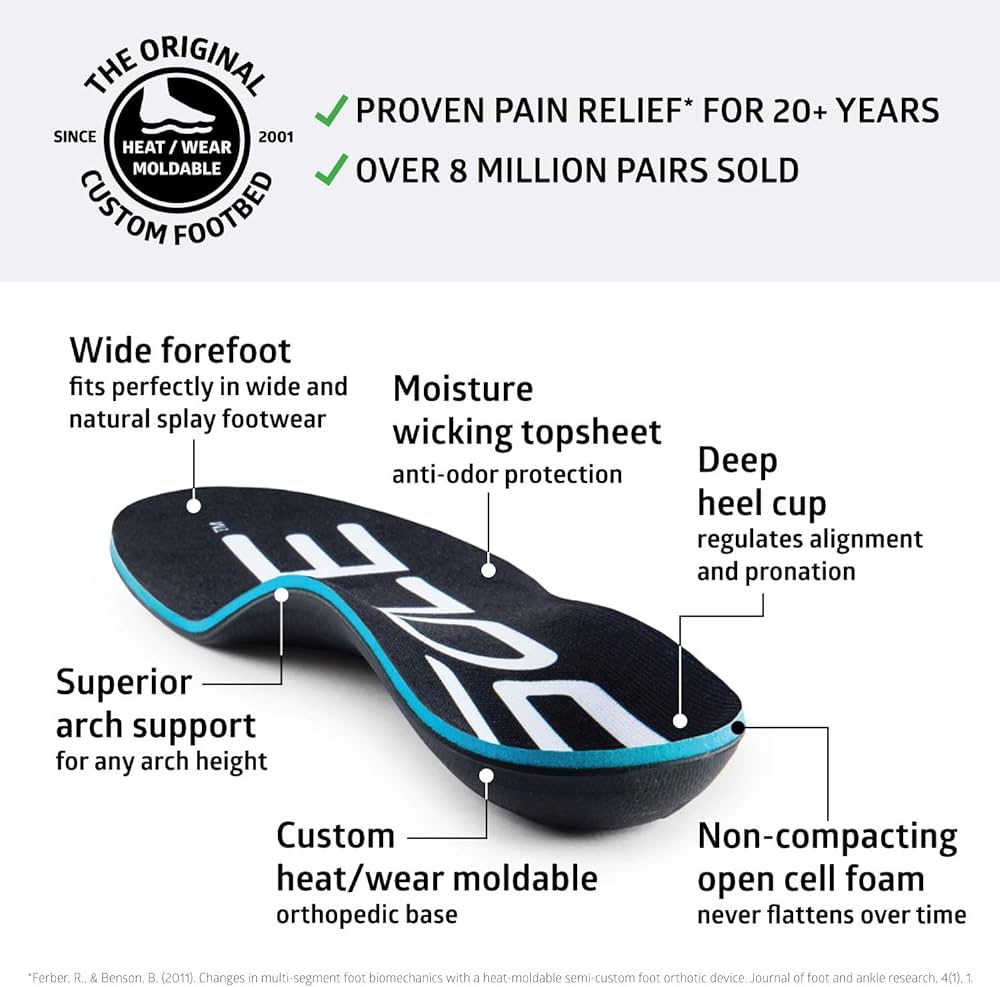
User Testimonials:
- Amy P.: “I’ve struggled with flat feet for years, and these insoles have been a game-changer. The arch support is fantastic, and they’re so comfortable.”
- Mark S.: “I appreciate the eco-friendly aspect of these insoles. Plus, they feel great in my hiking boots, providing the support I need for long hikes.”
- Karen L.: “The heat-moldable feature allowed me to get the perfect fit. I no longer have to worry about discomfort during long days on my feet.”
Recommendation:
Sole Active Thick Insoles come highly recommended for individuals seeking top-tier arch support, comfort, and sustainability in their footwear. Whether you have specific foot conditions or simply want to enhance the comfort of your shoes for everyday wear or outdoor activities, these insoles offer an impressive combination of support, cushioning, and eco-friendly materials. The heat-moldable feature ensures a customized fit, making them an excellent choice for those looking to alleviate foot discomfort and contribute to environmental conservation.
Pros & Cons:
| Pros | Cons |
| Superior Arch Support: These insoles excel in providing arch support, making them suitable for individuals with arch-related issues such as flat feet or high arches. | Price: Some users may find these insoles relatively more expensive compared to basic insoles available in the market. |
| Deep Heel Cup: The deep heel cup enhances stability and shock absorption, reducing the risk of overpronation and discomfort. | Bulky Design: Due to their thickness and deep heel cup, these insoles may not fit well in all types of shoes, particularly those with limited space inside. |
| Durable and Long-Lasting: They are built to last, maintaining their support and cushioning through extended use | May Require Heat Molding: While the heat-moldable feature is an advantage, it may require extra time and effort for users to achieve the perfect custom fit. |
| Customizable Fit: The heat-moldable feature allows for a tailored fit, enhancing overall comfort. | Limited Compatibility with Dress Shoes: Due to their thicker design and enhanced arch support, these insoles may not fit well in dress shoes with narrow or tight-fitting profiles. Users looking to improve comfort in formal or slim-fitting footwear may face challenges with fit. |
| Odor Resistance: The odor-resistant top layer helps keep shoes and feet fresh even after long hours of wear. | May Require Break-In Period: Some users may experience a break-in period where the insoles need time to conform to the shape of the foot and provide maximum comfort. During this initial period, they may feel slightly stiff or uncomfortable. |
Vionic Active Orthotic Insoles
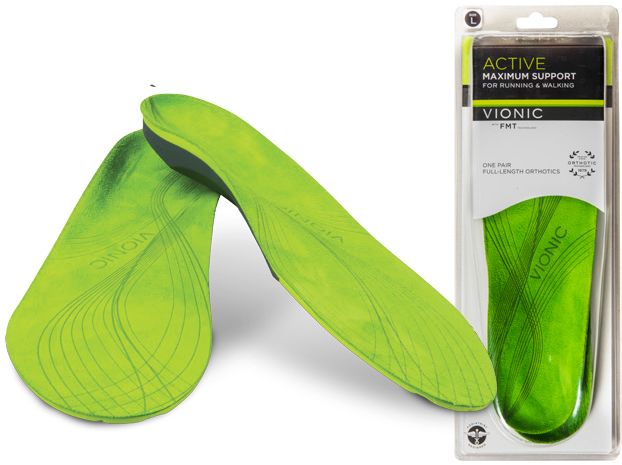
Key Features of Vionic Active Orthotic Insoles:
- Podiatrist-Designed: Vionic Active Orthotic Insoles are designed by podiatrists, ensuring their effectiveness in providing foot support and comfort.
- Biomechanical Design: These insoles have a biomechanical design that promotes natural foot alignment and reduces overpronation.
- Shock-Absorbing Material: They are made from shock-absorbing materials that cushion the feet, reducing impact and fatigue.
- Deep Heel Cup: The deep heel cup enhances stability and provides support to the heel and arch.
- Eco-Friendly: Vionic is committed to sustainability, and these insoles are made with eco-friendly materials.
- Versatile Fit: These insoles are designed to fit various types of footwear, including athletic shoes and casual shoes.
User Testimonials:
- Linda M.: “I’ve struggled with foot pain for years, but Vionic Active Orthotic Insoles have made a significant difference. They’re comfortable and supportive.”
- Robert S.: “I’m a runner, and these insoles have improved my gait and reduced fatigue during long runs. I can’t imagine running without them now.”
- Susan L.: “I appreciate the eco-friendly aspect of Vionic. Knowing that they’re made sustainably adds to their appeal.”
Recommendation:
Vionic Active Orthotic Insoles come highly recommended for individuals seeking expertly designed insoles that provide exceptional support and comfort. Whether you have specific foot conditions or simply want to enhance the comfort of your shoes for everyday wear or athletic activities, these insoles offer a winning combination of podiatrist expertise, biomechanical design, and shock absorption. The deep heel cup and eco-friendly materials make them a top choice for those looking to alleviate foot discomfort while contributing to environmental conservation.
Pros & Cons:
| Pros | Cons |
| Expert Design: These insoles are created by podiatrists, ensuring they meet high standards for foot support and comfort. | Price: Some users may find the cost of Vionic Active Orthotic Insoles relatively higher compared to standard insoles |
| Biomechanical Design: The design promotes natural foot alignment, making them suitable for individuals with overpronation issues. | Bulky Design: Due to their supportive features, these insoles may not fit well in very tight-fitting or low-profile shoes. |
| Superior Shock Absorption: The shock-absorbing materials reduce impact and provide excellent cushioning for all-day comfort. | May Require Adjustment Period: Users transitioning to these insoles may experience an adjustment period as their feet adapt to the new support and alignment. |
| Deep Heel Cup: The deep heel cup enhances stability and aids in reducing the risk of overpronation or discomfort. | Limited Style Options: Vionic Active Orthotic Insoles are primarily designed for functionality and foot support. As a result, they may have limited style options or aesthetics compared to insoles designed with fashion in mind. Users seeking fashionable or stylish insoles may find the choices somewhat restricted. |
| Eco-Friendly: Users appreciate that these insoles are made with eco-friendly materials, contributing to environmental sustainability | Initial Adjustment Period: Some users may experience an initial adjustment period when transitioning to Vionic Active Orthotic Insoles. This period may involve getting accustomed to the new foot alignment and support, which can take a little time before experiencing maximum comfort. |
Caring for Your Insoles
Caring for your insoles is essential to extend their lifespan and maintain their effectiveness. Here are some guidelines for proper insole care:
- Regular Cleaning: Clean your insoles regularly to prevent the buildup of bacteria and odors. For most insoles, a mild soap and water solution is sufficient. Use a soft brush or cloth to gently scrub the surface, then rinse with clean water.
- Air Dry Properly: After cleaning, air dry the insoles completely before placing them back in your shoes. Avoid exposing them to direct heat or sunlight, as this can damage the material.
- Odor Control: If odor is a concern, sprinkle baking soda on the insoles and leave them overnight. Baking soda is a natural odor absorber. You can also use specially designed foot powders or sprays.
- Rotate Insoles: If you use insoles daily, consider having two pairs and rotating them. This gives each pair time to air out, reducing moisture and extending their life.
- Check for Wear and Tear: Regularly inspect your insoles for signs of wear and tear. Look for thinning, cracking, or flattening, especially in areas of high pressure like the heel or ball of the foot.
- Trimming for Fit: If your insoles don’t fit perfectly into your shoes, you can trim them. Most insoles come with guidelines for trimming. Always trim conservatively to avoid cutting off too much.
- Proper Storage: When not in use, store your insoles in a cool, dry place. Keeping them flat helps maintain their shape.
- Use in Suitable Footwear: Ensure your shoes are in good condition and appropriate for the insoles. Worn-out or ill-fitting shoes can compromise the effectiveness of the insoles.
- Replacing Insoles: Be prepared to replace your insoles when they show significant signs of wear. On average, insoles may need replacing every 6-12 months, depending on usage.
- Follow Manufacturer’s Instructions: Always adhere to the care instructions provided by the insole manufacturer, as different materials may require different care methods.
Proper care and maintenance of your insoles not only enhance their function and comfort but also contribute to better foot health. Regular cleaning, careful use, and timely replacement are key aspects of insole care.
Common Myths about Insoles Debunked
There are several myths surrounding the use of insoles that can lead to misconceptions. Here are some of the common myths debunked by experts:
- Myth: Insoles Are Only for the Elderly or Athletes
- Truth: Insoles can benefit anyone, regardless of age or activity level. They are not just for athletes or older adults; they can provide comfort and support for various foot issues across all age groups.
- Myth: Insoles Will Immediately Solve All Foot Problems
- Truth: While insoles can alleviate discomfort and provide support, they are not a cure-all solution. Some foot conditions may require additional treatments or interventions.
- Myth: Insoles are Uncomfortable and Hard to Get Used To
- Truth: While there might be an adjustment period, most quality insoles are designed for comfort. Properly fitted insoles should not be uncomfortable. If they are, it may be a sign that they’re not the right fit for your feet.
- Myth: One Type of Insole Fits All
- Truth: Feet are unique, and what works for one person might not work for another. It’s important to choose insoles based on individual needs, foot shape, and specific issues.
- Myth: Insoles Weaken Feet Muscles
- Truth: Insoles do not weaken the muscles in your feet. They provide support and can help improve foot function, which may actually strengthen foot muscles over time.
- Myth: Custom Insoles Are Always Better Than Off-the-Shelf
- Truth: Custom insoles are tailored to your feet and can offer specific benefits, but off-the-shelf insoles can also be highly effective, especially for people with common foot types and issues.
- Myth: Expensive Insoles Are Always the Best Option
- Truth: Price is not always an indicator of quality. There are many affordable insoles that provide excellent support and comfort. It’s more important to find insoles that suit your specific needs.
- Myth: Insoles Only Help with Foot Pain
- Truth: Insoles not only help with foot pain but can also alleviate discomfort in other areas of the body, like the knees, hips, and lower back, by improving foot alignment and gait.
- Myth: Insoles are Unnecessary if You Have Good Shoes
- Truth: Even high-quality shoes may not provide the specific support or cushioning needed for your foot type or condition. Insoles can enhance the support and comfort of your shoes.
- Myth: Insoles Can Fix Any Shoe
- Truth: While insoles can improve the fit and comfort of many shoes, they cannot correct issues with shoes that are poorly designed, too tight, or structurally unsound.
Insoles and Overall Foot Health
Insoles play a crucial role in promoting overall foot health, especially for individuals with specific foot conditions like high arches. Here’s how insoles contribute to foot health:
- Improved Support and Alignment: Insoles provide necessary support to the foot’s arch, helping in maintaining proper alignment. This is particularly important for those with high arches, as they often lack natural arch support.
- Enhanced Shock Absorption: Good insoles absorb the impact that feet endure with each step, especially during activities like running or walking on hard surfaces. This reduces the stress on the feet, ankles, knees, and even the lower back.
- Alleviation of Foot Pain: Insoles can significantly reduce foot pain caused by conditions like plantar fasciitis, metatarsalgia, and other arch-related issues. By providing proper cushioning and support, insoles help in distributing pressure more evenly across the foot.
- Prevention of Further Foot Problems: Regular use of appropriate insoles can prevent the development of more serious foot issues. They help in correcting abnormal walking patterns and reduce the strain on the feet.
- Improved Posture and Gait: By aligning the feet properly, insoles can also positively affect your overall posture and walking pattern. This can lead to reduced pain and discomfort in other parts of the body like the hips, knees, and lower back.
- Enhanced Comfort During Activities: Insoles make daily activities and prolonged periods of standing or walking more comfortable. This can improve overall foot health and well-being.
- Reduced Risk of Injuries: For athletes or individuals engaged in regular physical activities, insoles can decrease the risk of injuries related to poor foot mechanics, such as ankle sprains or stress fractures.
- Assistance in Foot Development: Insoles can be particularly beneficial for children and teenagers, whose feet are still developing. They can assist in guiding the feet into a healthier alignment during these formative years.
- Beneficial for Diabetic Foot Care: For people with diabetes, insoles play a key role in preventing foot ulcers and other complications. Diabetic insoles are designed to reduce pressure points and enhance circulation.
- Compatibility with Orthopedic Treatments: Insoles can be an integral part of treatment for various orthopedic conditions of the foot and ankle, complementing other treatments like physiotherapy or medication.
FAQs
- How often should I replace my insoles? Typically every 6-12 months, depending on usage and signs of wear.
- Can insoles help with knee pain? Yes, insoles can help align the feet and reduce strain on the knees.
- Are custom insoles worth the cost? For those with specific needs, custom insoles can provide tailored support that off-the-shelf options cannot match.
- Do I need special shoes for high-arch insoles? Shoes with enough room and support for the insoles are ideal.
- Can insoles cure foot problems? While they can alleviate symptoms, it’s important to consult a healthcare professional for underlying foot problems.
